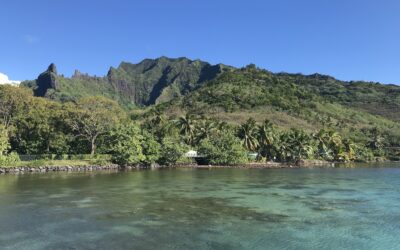Fourteen heiau, sacred waterways, fishponds, lava tubes, caves hosting the rarest species in the world, and cultural richness beyond description is now the history of Kōloa. The waters once so pure, you could drink from the stream now feed the golf courses of the wealthy. Desecration of the land has been a repeating pattern, that unfortunately won’t stop with the new developers looking to capitalize on what is left. In the last year, over 10,000 acres were purchased and deemed “opportunity zones” by foreign investors in partnership with the county. They are now some of the largest landowners on Kaua’i. The people are hurting, the land is forsaken, and the waters are no longer pure. All for the gain of money that won’t stay in our community. Kōloa is a geologically and culturally significant ahupua’a, and the desecration must stop.
Bernice Judd, writing in 1935, summarizes most of what was known into the first decades of this century of the traditional Hawaiian life of Kōloa: “In the old days two large ‘auwai or ditches left the southern end of the Maulili pool to supply the taro patches to the east and west. On the kuaunas or embankments the natives grew bananas and sugar cane for convenience in irrigating. Along the coast they had fish ponds and salt pans, ruins of which are still to be seen. Their dry land farming was done on the kula, where they raised sweet potatoes, of which both the tubers and the leaves were good to eat. The Hawaiians planted pia (arrowroot) as well as wauke (mulberry) in patches in the hills wherever they would grow naturally with but little cultivation. In the uplands they also gathered the leaves of the hala for mats and the nuts of the kukui for light.” (Judd 1935:53) I can picture the soil teeming with life, the sounds of native birds, and powerful chants in the native Hawaiian language.
Development and displacement have been a constant since the start of the nineteenth century. “On December 31, 1834, Peter Gulick and his family arrived in Kōloa. Apparently, the first foreigners to settle in the area, they initiated the process of rapid change that would re-shape the life of Kōloa in the nineteenth century.” (TMK: [4] 2-9-002:001) The sugar plantation era had begun. People migrated from all over the world for investment opportunities, plantation work, and missionary conquests. The remnants of sugar mills and religious settlements are scattered throughout Kōloa to this day. Meanwhile, burial grounds are disrupted, heiau are mistreated and the lo’i can no longer be sustained.
In Hawaiian, wai means water. Wai is the source of life. The term waiwai means abundance, prosperity, or wealth. It is no surprise that developers have always sought after gaining control of the water sources. Gaining access to water would allow sugar plantations to produce more crops and contribute to more wealth. Hotels and golf courses require large amounts of water to operate. The desire to control the water hasn’t stopped, but the demand has grown. Ownership has been transferred from one businessman to another at the expense of our ecosystems and way of life.
Pollution runoff from years of agriculture, golf course pesticides, large hotel sewage systems and modern-day chemicals have wreaked havoc on not only the land, but the ocean as well. Native species have gone extinct or critically endangered, coral reefs are dying and invasive species are thriving. Waikomo Stream, once used to sustain life for the Hawaiian people, is now one of the most polluted streams on the island. It flows directly into the ocean at Kōloa Landing. A place that once was the busiest port on Kaua’i.
Kōloa town is now filled with luxury resorts instead of thriving ahupua’a. “By the late 1960s, the main town of Kōloa experienced a type of reverse migration back to the shoreline. Although the town had established a Civic Center in 1977, the pace of tourist-driven development at the shoreline had been drawing construction and service jobs away from the town center. In 1962, the Wai‘ohai Resort opened, with the Sheraton Kaua‘i Resort following in 1965. The Kīahuna Plantation Resort opened in 1967, followed by the construction of various condominiums throughout the ’70s and ’80s. Finally, the Hyatt Regency Resort, with its’ expansive golf course, opened in 1991. By this time, the tourist industry had successfully attached the name “Po‘ipū Beach” to the entire coastline beginning just west of the subject parcel at Kōloa Landing, and continuing east to Makahū‘ena Ledge. With the development of the Po‘ipū Bay Resort Golf Course and the Hyatt Regency Kaua‘i Resort Hotel, the Po‘ipū Beach name became synonymous with all two miles of coastline fronting the Wai‘ohai, Kiahuna, and Sheraton developments; ending at Po‘ipū Beach Park.” (Donohugh 2001) Developers are not satisfied with the current accommodations and have plans to further expand.
Gary Pinkston, Chad Brue, and Geoff Baukol, new developers just bought regions of Omao, Kukuiula, Kalaheo, and 10,000 acres of conservation land in Wainiha. The county has deemed all of these areas as “opportunity zones.” I did some research and found on the county website that an opportunity zone is merely a tax incentive for investors to develop on untouched land. “The recently passed Federal Tax Cuts and Jobs Act of 2017 authorized a community economic development program called the Opportunity Zones Program. This initiative provides incentives for investors to re-invest realized capital gains into Opportunity Funds in exchange for temporary tax deferral and other benefits.” The developers state on their website: “Kukui‘ula is a spectacular master-planned resort community that captures the very best of the Kaua‘i lifestyle with unequaled beauty, casual elegance, and plenty of Ho‘okipa (heartfelt Hawaiian hospitality). Occupying more than 1,000 acres along the beautiful South Shore of Kaua‘i, between the National Tropical Botanical Garden and Old Koloa Town, Kukui‘ula is the island’s only private club and golf course community.” It doesn’t feel right to me that “heartfelt Hawaiian hospitality” includes the desecration of their very own land. All so the investors can add a few more million dollars to their 1.1 billion dollar real estate investment portfolio.
I am not from Kōloa, I am from Kapa’a. However, I have spent a lot of time in this ahupua’a. I am a surfer and love the waves of the south shore. Sitting on the beach, you can feel the history. The power of the waves has remained the same throughout all the years despite the changes on land. The people of Kaua’i are fed up and are coming together to stand up for what we believe in. The preservation of our land is more important than accommodating more visitors in luxury hotels. We must act before it is too late.
Works Cited
“Bruce & Baukol .” Brue Baukol Capital Partners, https://www.bruebaukol.com/about/.
Donohugh, Donald. The Story of Kōloa: A Kauaʻi Plantation Town. Mutual Pub., 2001.
K, T M. “Section 6 Kōloa, Pā‘ā Ahupua‘a.” Kauai.gov, http://www.kauai.gov/Portals/0/PW_SolidWaste/Mayors%20Rpt%20Vol%202_AppendixB_Tab11_Section6.pdf.
“Opportunity Zones.” Hawaii Opportunity Zones, https://invest.hawaii.gov/oz/about/.
Save Koloa. “Save Koloa.” Save Koloa, https://savekoloa.com/.
Section 8 Kālepa, Hanamā‘Ulu and Wailua Ahupua‘a – Kauai.gov. https://www.kauai.gov/Portals/0/PW_SolidWaste/Mayors%20Rpt%20Vol%202_AppendixB_Tab11_Section8.pdf.
Wichman, Frederick B. Kauaʻi: Ancient Place-Names and Their Stories. University of Hawaiʻi Press, 2006.
Moments From Moorea
I spent a week traveling to the islands of Tahiti and Moorea. This was an incredible surf trip. Welcome to the first entry of my surf diaries.
Napoleon Hill’s 28 Questions To Ask Yourself
A book that has been integral to my goal setting and achieving strategies is Think and Grow Rich by Napoleon Hill. I have read it a couple times now and will probably read it a few more. It was written in 1937 and the knowledge in this book is more applicable than ever before.
Energy
Highs and lows are inevitable in life, but energy is constant. We must learn to channel our energy.




Recent Comments